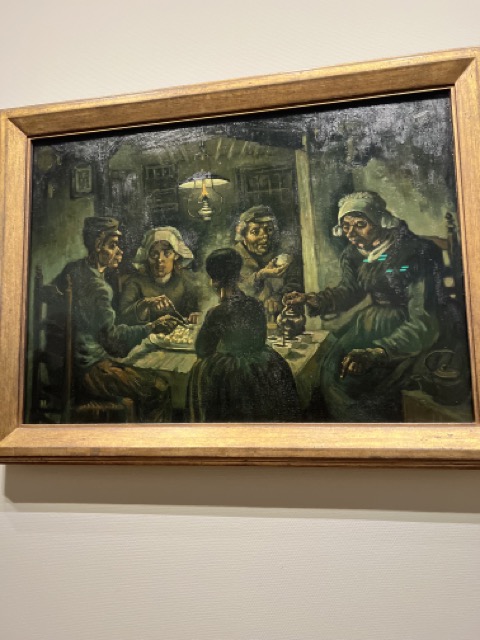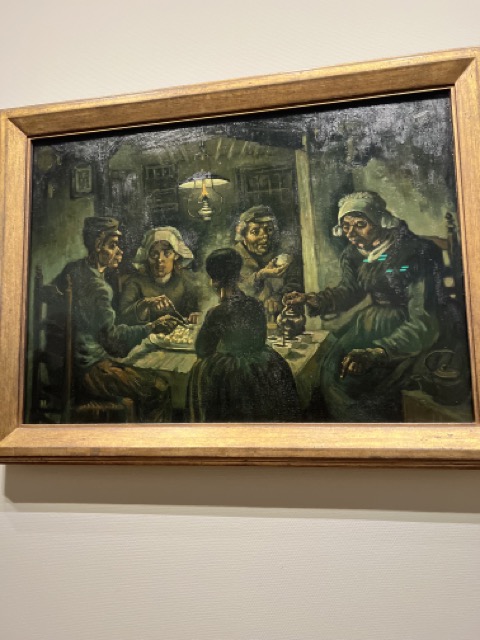The Potato Eaters, Vincent Van Gogh
Italian Version Below*
In 1885, Vincent was 32 years old, paradoxical to believe that after 5 years, he will kill himself.
After a stay in Nuenen (Holland) in a peasant village and numerous preparatory studies, Vincent created what he would consider one of his masterpieces and the best he had done: The Potato Eaters.
Critics unanimously consider it the pinnacle of the Dutch period.
The tones are dark, the brushstrokes are decisive but very far from the stylistic trait that will emerge in the following years. The light from the lantern is the only source of illumination for the entire scene and, although dim, it manages to highlight the faces of the 5 characters intent on eating and drinking during a frugal evening meal.
We recognize the face of Gordina de Groot, a woman present in other works by Vincent who wears the typical headdress of Dutch peasant women.
The scene is raw, realistic, and far from the romantic meaning with which other artists, his contemporaries, portrayed the same subject in the same period.
Vicent himself will clarify the meaning of the painting in one of the letters he wrote to his brother Theo:
“I tried to underline how these people who eat potatoes by lamplight have dug the earth with the same hands that they now extend into the plate, and therefore I speak of manual labor. Whoever prefers to see farmers in their Sunday best, do as you wish. I am convinced that the best results are obtained by painting them in all their roughness rather than giving them a conventionally graceful appearance.”
The work is exhibited at the Van Gogh Museum in Amsterdam.

All rights reserved*
Follow me on IG: selenia_eyeonart
I Mangiatori di Patate, Vincent Van Gogh
Siamo nel 1885, Vincent ha 32 anni, paradossale credere che da lì a 5 anni, con un colpo di rivoltella porrà fine alla sua vita. Dopo un soggiorno a Nuenen (Olanda) in un villaggio di contadini e numerosissimi studi preparatori, Vincent realizza quello che lui stesso considererà uno dei suoi capolavori e ciò che di meglio avesse fatto: I Mangiatori Patate.
Unanimemente la critica lo considera come l’apice del periodo olandese.
I toni sono scuri, le pennellate decise, ma lontanissime dal tratto stilistico che emergerà negli anni successivi. La luce della lanterna è l’unica fonte di illuminazione e, seppur fioca, riesce ad evidenziare i volti dei 5 personaggi intenti a mangiare e bere durante un frugale pasto serale.
Riconosciamo il volto di Gordina de Groot, una donna presente in altre opere di Vincent che indossa il copricapo tipico delle contadine olandesi.
La scena è cruda, realistica, ben lontana dall’accezione romantica con cui nel medesimo periodo altri artisti, suoi contemporanei, ritraevano lo stesso soggetto.
Sarà lo stesso Vincent in una delle Lettere che scriverà a suo fratello Theo, a chiarire il significato del dipinto:
“Ho cercato di sottolineare come questa gente che mangia patate al lume della lampada ha zappato la terra con le stesse mani che ora protende nel piatto, e quindi parlo di lavoro manuale. Chi preferisce vedere i contadini con il vestito della domenica, faccia pure, come vuole. Personalmente sono convinto che i risultati migliori si ottengano dipingendoli in tutto la loro rozzezza piuttosto che dando loro un asopetto convenzionalmente aggraziato”.
L’opera è esposta presso il Museo Van Gogh di Amsterdam.

Seguimi su IG: selenia_eyeonart
Tutti i diritti sono riservati. E’ vietata qualsiasi utilizzazione, totale o parziale, dei contenuti inseriti nel presente portale, ivi inclusa la memorizzazione, riproduzione, rielaborazione, diffusione o distribuzione dei contenuti stessi mediante qualunque piattaforma tecnologica, supporto o rete telematica, senza previa autorizzazione scritta di Selenia Morgillo.